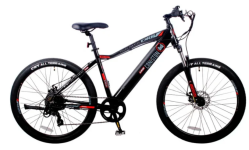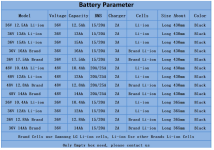jimmyjimmyjayjay
1 mW
I have a 250W rear hub motor. 36V 13.8 Ah battery. I am going to install a KT15A controller and KT LCD8 display. Im not sure of the gear ratio of the motor I think its a Shengyi SY73627.5VE0592S6
Could someone help with parameter settings to set this all up?
Also what are my options for squeezing the most out of this motor?
Am I right in thinking I can get a bigger controller and adjust the settings to limit the output? What are the advantages and disadvantages of this? Is it worth it with 250w motor?
I'm not expecting much but just want to optimise as best I can. Any advice will be gratefully received! Im a newb but I can spin a spanner and I'm keen! Should probably mention that I'm an electrician so I'm pretty happy tearing things apart and pretending I know how to put them back together. Thanks in advance! Sorry if this is a repeated topic but i'm finding the search function a bit clunky.
Battery specs below..

 www.coppercell.com.tw
Cell Type : 18650 – 2.6A / 2.9A / 3.45A
www.coppercell.com.tw
Cell Type : 18650 – 2.6A / 2.9A / 3.45A
Max Cell Space : 18650 * 40pc
Max Capacity : 36V / 13.8Ah ; 48V / 10.35Ah ; 496Wh
Dimension : 431.3mm * 105.2mm * 64.3mm ( PRO Type )
Housing: Aluminum
Waterproof : IPX-5
communication: UART / CANBUS
Capacity LED Display : YES.
BMS EN13849 certificated : YES
Thanks again!
Could someone help with parameter settings to set this all up?
Also what are my options for squeezing the most out of this motor?
Am I right in thinking I can get a bigger controller and adjust the settings to limit the output? What are the advantages and disadvantages of this? Is it worth it with 250w motor?
I'm not expecting much but just want to optimise as best I can. Any advice will be gratefully received! Im a newb but I can spin a spanner and I'm keen! Should probably mention that I'm an electrician so I'm pretty happy tearing things apart and pretending I know how to put them back together. Thanks in advance! Sorry if this is a repeated topic but i'm finding the search function a bit clunky.
Battery specs below..

E-Bike - Coppercell | 駿雅科技股份有限公司
E-bike DOWN TUBE SEAT TUBE ON FRAME REAR CARRIED FRAME [...]
 www.coppercell.com.tw
www.coppercell.com.tw
Max Cell Space : 18650 * 40pc
Max Capacity : 36V / 13.8Ah ; 48V / 10.35Ah ; 496Wh
Dimension : 431.3mm * 105.2mm * 64.3mm ( PRO Type )
Housing: Aluminum
Waterproof : IPX-5
communication: UART / CANBUS
Capacity LED Display : YES.
BMS EN13849 certificated : YES
Thanks again!



